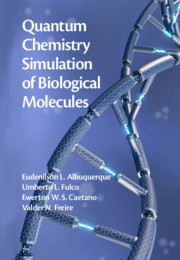Book contents
- Frontmatter
- Contents
- Preface
- Figure Credits
- 1 Basic Properties of Quantum Chemistry
- 2 Charge Transport in the DNA Molecule
- 3 Electronic Transmission Spectra of the DNA Molecule
- 4 Thermodynamic Properties of the DNA Molecule
- 5 Properties of the DNA/RNA Nucleobases
- 6 Molecular Electronics
- 7 Amino Acid Anhydrous Crystals
- 8 Protein–Protein Systems
- 9 Ascorbic Acid and Ibuprofen Drugs
- 10 Cholesterol-Lowering Drugs
- 11 Collagen-Based Biomaterials
- 12 Antimigraine Drugs
- 13 Antiparkinson Drugs
- 14 Central Nervous System Disorders
- 15 The Biology of Cancer
- 16 Concluding Remarks
- Bibliography
- Index
16 - Concluding Remarks
Published online by Cambridge University Press: 21 January 2021
- Frontmatter
- Contents
- Preface
- Figure Credits
- 1 Basic Properties of Quantum Chemistry
- 2 Charge Transport in the DNA Molecule
- 3 Electronic Transmission Spectra of the DNA Molecule
- 4 Thermodynamic Properties of the DNA Molecule
- 5 Properties of the DNA/RNA Nucleobases
- 6 Molecular Electronics
- 7 Amino Acid Anhydrous Crystals
- 8 Protein–Protein Systems
- 9 Ascorbic Acid and Ibuprofen Drugs
- 10 Cholesterol-Lowering Drugs
- 11 Collagen-Based Biomaterials
- 12 Antimigraine Drugs
- 13 Antiparkinson Drugs
- 14 Central Nervous System Disorders
- 15 The Biology of Cancer
- 16 Concluding Remarks
- Bibliography
- Index
Summary
Computational quantum chemistry is one of the most successful techniques to calculate the main properties of molecules and solids. It is also widely used in the design of new pharmaceutical drugs and biological materials. In general, it is based entirely on quantum mechanics and its basic physical constants, the so-called ab initio method. Usually, the unveiling of the DNA molecule, as well as the secondary structure (alpha-helix and beta-sheet) in proteins, in the 1950s, together with other relevant breakthrough discoveries, marked its dawn. Since then, many achievements in biology, chemistry, physics, and pharmaceutical science were obtained, leading to its solid reputation as a primer tool now available to scientists. It allows investigations with greater accuracy and at an unprecedented level of detail, leading not only to the ability to make a direct comparison with experimental data but also even to predict hitherto unobservedimportant phenomena.
Keywords
- Type
- Chapter
- Information
- Quantum Chemistry Simulation of Biological Molecules , pp. 382 - 388Publisher: Cambridge University PressPrint publication year: 2021



